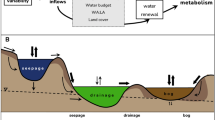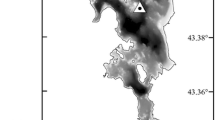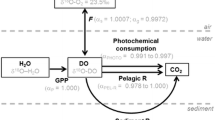Abstract
Northern regions host the greatest density of surface water globally, but knowledge of lake metabolism in this vast yet remote landscape is limited. Here, we used an oxygen stable isotope approach to quantify patterns and drivers of surface layer metabolism in lakes throughout an approximately 106 km2 tract of boreal Canada. Ecosystem gross primary production (GPP) and respiration rates (R) were much higher than previously assumed for spring and summer months. Both rates were strongly linked to nitrogen (N) concentrations, not light availability, despite earlier work showing community-level light effects. Net ecosystem production (NEP = GPP − R) was negative for most lakes. Hierarchical modeling revealed that although NEP is strongly stabilized via similar effects of N on both GPP and R, NEP decreases with increasing dissolved organic carbon (DOC). These interactive controls on NEP were not predictable from bivariate regressions linking NEP to physical, chemical or habitat-specific drivers. In contrast to expectations, NEP was higher in warmer waters due to increased temperature dependency of GPP, not R. Temperature and DOC content had opposing effects on NEP in all but the most dystrophic lakes, possibly implying a muted response of metabolic balances to future shifts in both regional climate and OC delivery.





Similar content being viewed by others
References
Allen AP, Gillooly JF, Brown JH. 2005. Linking the global carbon cycle to individual metabolism. Funct Ecol 19:202–13.
Ask J, Karlsson J, Jansson M. 2012. Net ecosystem production in clear-water and brown-water lakes. Global Biogeochem Cycles 26:GB1017.
Barkan E, Luz B. 2005. High precision measurements of 17O/16O and 18O/16O ratios in H2O. Rapid Commun Mass Spectrom 19:3737–42.
Bender M, Grande K, Johnson K, Marra J, Williams PJL, Sieburth J, Pilson M, Langdon C, Hitchcock G, Orchardo J, Hunt C, Donaghay P, Heinemann K. 1987. A comparison of four methods for determining planktonic community production. Limnol Oceanogr 32:1085–98.
Benson BB, Krause D. 1984. The concentration and isotopic fractionation of oxygen dissolved in freshwater and seawater in equilibrium with the atmosphere. Limnol Oceanogr 29:620–32.
Bergström A-K. 2010. The use of TN:TP and DIN:TP ratios as indicators for phytoplankton nutrient limitation in oligotrophic lakes affected by N deposition. Aquat Sci 72:277–81.
Bocaniov SA, Schiff SL, Smith REH. 2012. Plankton metabolism and physical forcing in a productive embayment of a large oligotrophic lake: insights from stable oxygen isotopes. Freshw Biol 57:481–96.
Bocaniov SA, Schiff SL, Smith REH. 2015. Non steady-state dynamics of stable oxygen isotopes for estimates of metabolic balance in large lakes. J Great Lakes Res 41:719–29.
Bogard MJ, del Giorgio PA. 2016. The role of metabolism in modulating CO2 fluxes in boreal lakes. Global Biogeochem Cycles 30:1509–25.
Bogard MJ, Vachon D, St.-Gelais NF, del Giorgio PA. 2017. Using oxygen stable isotopes to quantify ecosystem metabolism in northern lakes. Biogeochemistry 133:347–64.
Bogard MJ, Kuhn CD, Johnston SE, Striegl RG, Holtgrieve GW, Dornblaser MM, Spencer RGM, Wickland KP, Butman DE. 2019a. Negligible cycling of terrestrial carbon in many lakes of the arid circumpolar landscape. Nature Geoscience 12:180–5.
Bogard MJ, Johnston SE, Dornblaser MM, Spencer RGM, Striegl RG, Butman DE. 2019b. Extreme rates and diel variability of planktonic respiration in a shallow sub-arctic lake. Aquatic Sciences 81:60.
Brothers S, Vadeboncoeur Y, Sibley P. 2016. Benthic algae compensate for phytoplankton losses in large aquatic ecosystems. Glob Chang Biol 1:3865–73.
Carignan R, Planas D, Vis C. 2000. Planktonic production and respiration in oligotrophic shield lakes. Limnol Oceanogr 45:189–99.
del Giorgio PA, Peters RH. 1994. Patterns in planktonic P: R ratios in lakes: Influence of lake trophy and dissolved organic carbon. Limnol Oceanogr 39:772–87.
Denfeld BA, Baulch HM, del Giorgio PA, Hampton SE, Karlsson J. 2018. A synthesis of carbon dioxide and methane dynamics during the ice-covered period of northern lakes. Limnol Oceanogr Lett 3:117–31.
Dubois K, Carignan R, Veizer J. 2009. Can pelagic net heterotrophy account for carbon fluxes from eastern Canadian lakes? Appl Geochemistry 24:988–98.
Ducharme-Riel V, Vachon D, del Giorgio PA, Prairie YT. 2015. The relative contribution of winter under-ice and summer hypolimnetic CO2 accumulation to the annual CO2 emissions from northern lakes. Ecosystems 18:547–59.
Fee EJ, Shearer JA, DeBruyn ER, Schindler EU. 1992. Effects of lake size on phytoplankton photosynthesis. Can J Fish Aquat Sci 49:2445–59.
Finlay K, Vogt RJ, Bogard MJ, Wissel B, Tutolo BM, Simpson GL, Leavitt PR. 2015. Decrease in CO2 efflux from northern hardwater lakes with increasing atmospheric warming. Nature 519:215–18.
Gauthier S, Bernier P, Kuuluvainen T, Shvidenko AZ, Schepaschenko DG. 2015. Boreal forest health and global change. Science 349:819–22.
Guy RD, Fogel ML, Berry JA. 1993. Photosynthetic fractionation of the stable isotopes of oxygen and carbon. Plant Physiol 101:37–47.
Harrell FE. 2017. Package ‘Hmisc’. Version 4. https://cran.r-project.org/web/packages/Hmisc/index.html.
Heathcote AJ, Giorgio PA, Prairie YT. 2015. Predicting bathymetric features of lakes from the topography of their surrounding landscape. Can J Fish Aquat Sci 650:643–50.
Holtgrieve GW, Schindler DE, Hobbs WO, Leavitt PR, Ward EJ, Bunting L, Chen G, Finney BP, Gregory-Eaves I, Holmgren S, Lisac MJ, Lisi PJ, Nydick K, Rogers LA, Saros JE, Selbie DT, Shapley MD, Walsh PB, Wolfe AP. 2011. A coherent signature of anthropogenic nitrogen deposition to remote watersheds of the Northern Hemisphere. Science 334:1545–8.
Hotchkiss ER, Hall ROJ. 2014. High rates of daytime respiration in three streams: Use of δ18OO2 and O2 to model diel ecosystem metabolism. Limnol Oceanogr 59:798–810.
Jahne B, Munnich Otto K, Boilnger R, Dutzi A, Huber W, Libner P. 1987. On the parameters influencing air-water gas exchange. J Geophys Res 92:1937–49.
Johnson JB, Omland KS. 2004. Model selection in ecology and evolution. Trends Ecol Evol 19:101–8.
Jones RI. 1992. The influence of humic substances on lacustrine planktonic food chains. Dissolved Organic Matter in Lacustrine Ecosystems: Energy Source and System Regulator. Dordrecht: Springer, Netherlands. p 73–91.
Jonsson A, Meili M, Bergstrom AK, Jansson M. 2001. Whole-lake mineralization of allochthonous and autochthonous organic carbon in a large humic lake (Ortrasket, N. Sweden). Limnol Oceanogr 46:1691–700.
Kelly PT, Solomon CT, Zwart JA, Jones SE. 2018. A framework for understanding variation in pelagic gross primary production of lake ecosystems. Ecosystems. 21:1364–76.
Knox M, Quay PD, Wilbur D. 1992. Kinetic isotopic fractionation during air-water gas transfer of O2, N2, CH4, and H2. J Geophys Res 97:335–43.
Kortelainen P, Rantakari M, Pajunen H, Huttunen JT, Mattsson T, Juutinen S, Larmola T, Alm J, Silvola J, Martikainen PJ. 2013. Carbon evasion/accumulation ratio in boreal lakes is linked to nitrogen. Global Biogeochem Cycles 27:363–74.
Kritzberg ES, Granéli W, Björk J, Brönmark C, Hallgren P, Nicolle A, Persson A, Hansson L-A. 2014. Warming and browning of lakes: consequences for pelagic carbon metabolism and sediment delivery. Freshw Biol 59:325–36.
Lapierre JF, Seekell DA, del Giorgio PA. 2015. Climate and landscape influence on indicators of lake carbon cycling through spatial patterns in dissolved organic carbon. Glob Chang Biol 21:4425–35.
Larsen S, Andersen T, Hessen DO. 2011. Climate change predicted to cause severe increase of organic carbon in lakes. Glob Chang Biol 17:1186–92.
Laudon H, Spence C, Buttle J, Carey SK, McDonnell JJ, McNamara JP, Soulsby C, Tetzlaff D. 2017. Save northern high-latitude catchments. Nat Geosci 10:324–5.
Lauster GH, Hanson PC, Kratz TK. 2006. Gross primary production and respiration differences among littoral and pelagic habitats in northern Wisconsin lakes. Can J Fish Aquat Sci 63:1130–41.
Leavitt PR, Fritz SC, Anderson NJ, Baker PA, Blenckner T, Bunting L, Catalan J, Conley DJ, Hobbs WO, Jeppesen E, Korhola A, McGowan S, Ruehland K, Rusak JA, Simpson GL, Solovieva N, Werne J. 2009. Paleolimnological evidence of the effects on lakes of energy and mass transfer from climate and humans. Limnol Oceanogr 54:2330–48.
Lepori F, Keck F. 2012. Effects of atmospheric nitrogen deposition on remote freshwater ecosystems. Ambio 41:235–46.
Marchand D, Prairie YT, del Giorgio PA. 2009. Linking forest fires to lake metabolism and carbon dioxide emissions in the boreal region of Northern Quebec. Glob Chang Biol 15:2861–73.
Nurnberg GK, Shaw M. 1998. Productivity of clear and humic lakes: Nutrients, phytoplankton, bacteria. Hydrobiologia 382:97–112.
O’Reilly CM, Sharma S, Gray DK, Hampton SE, Read JS, Rowley RJ, Schneider P, Lenters JD, McIntyre PB, Kraemer BM, Weyhenmeyer GA, Straile D, Dong B, Adrian R, Allan MG, Anneville O, Arvola L, Austin J, Bailey JL, Baron JS, Brookes JD, de Eyto E, Dokulil MT, Hamilton DP, Havens K, Hetherington AL, Higgins SN, Hook S, Izmest’eva LR, Joehnk KD, Kangur K, Kasprzak P, Kumagai M, Kuusisto E, Leshkevich G, Livingstone DM, MacIntyre S, May L, Melack JM, Mueller-Navarra DC, Naumenko M, Noges P, Noges T, North RP, Plisnier P-D, Rigosi A, Rimmer A, Rogora M, Rudstam LG, Rusak JA, Salmaso N, Samal NR, Schindler DE, Schladow SG, Schmid M, Schmidt SR, Silow E, Soylu ME, Teubner K, Verburg P, Voutilainen A, Watkinson A, Williamson CE, Zhang G. 2015. Rapid and highly variable warming of lake surface waters around the globe. Geophys Res Lett 42:10,773-10,781.
Oksanen J, Blanchet FG, Friendly M, Kindt R, Legendre P, Mcglinn D, Minchin PR, O’Hara RB, Simpson GL, Solymos P, Stevens MHH, Szoecs E, Wagner H. 2017. Vegan Community Ecology Package. https://github.com/vegandevs/vegan/issues.
Pace ML, Prairie YT. 2005. Respiration in Lakes. In: del Giorgio PA, Williams PJL, Eds. Respiration in Aquatic Ecosystems. Oxford: New York, NY. p 103–21.
Pollard PC. 2013. In situ rapid measures of total respiration rate capture the super labile DOC bacterial substrates of freshwater. Limnol Oceanogr Methods 11:584–93.
R-development-core-team. 2017. R: A Language and Environment for Statistical Computing. R Found Stat Comput. http://www.r-project.org.
Rasilo T, Prairie YT, del Giorgio PA. 2015. Large-scale patterns in summer diffusive CH4 fluxes across boreal lakes, and contribution to diffusive C emissions. Glob Chang Biol 21:1124–39.
Rodríguez P, Byström P, Geibrink E, Hedström P, Vasconcelos FR, Karlsson J. 2016. Do warming and humic river runoff alter the metabolic balance of lake ecosystems? Aquat Sci 78:717–25.
Rosseel Y. 2012. lavaan: An R Package for Structural Equation Modeling. J Stat Softw 48:1–36. https://cran.r-project.org/web/packages/lavaan/citation.html.
Sand-jensen K, Staehr PA. 2009. Net heterotrophy in small Danish lakes: A widespread feature over gradients in trophic status and land cover. Ecosystems 12:336–48.
Schindler DW, Bayley SE, Parker BR, Beaty KG, Cruikshank DR, Fee EJ, Schindler EU, Stainton MP. 1996. The effects of climatic warming on the properties of boreal lakes and streams at the Experimental Lakes Area, northwestern Ontario. Limnol Oceanogr 41:1004–17.
Seekell DA, Lapierre JF, Ask J, Bergström AK, Deininger A, Rodriguez P, Karlsson J. 2015. The influence of dissolved organic carbon on primary production in northern lakes. Limnol Oceanogr 60:1276–85.
Smol JP, Wolfe AP, Birks HJB, Douglas MSV, Jones VJ, Korhola A, Pienitz R, Rühland K, Sorvari S, Antoniades D, Brooks SJ, Fallu M-A, Hughes M, Keatley BE, Laing TE, Michelutti N, Nazarova L, Nyman M, Paterson AM, Perren B, Quinlan R, Rautio M, Saulnier-Talbot É, Siitonen S, Solovieva N, Weckström J. 2005. Climate-driven regime shifts in the biological communities of arctic lakes. Proc Natl Acad Sci USA 102:4397–402.
Solomon CT, Bruesewitz DA, Richardson DC, Rose KC, Van de Bogert MC, Hanson PC, Kratz TK, Larget B, Adrian R, Leroux Babin B, Chiu CY, Hamilton DP, Gaiser EE, Hendricks S, Istvá V, Laas A, O’Donnell DM, Pace ML, Ryder E, Staehr PA, Torgersen T, Vanni MJ, Weathers KC, Zhu G. 2013. Ecosystem respiration: Drivers of daily variability and background respiration in lakes around the globe. Limnol Oceanogr 58:849–66.
Solomon CT, Jones SE, Weidel BC, Buffam I, Fork ML, Karlsson J, Larsen S, Lennon JT, Read JS, Sadro S, Saros JE. 2015. Ecosystem consequences of changing inputs of terrestrial dissolved organic matter to lakes: Current knowledge and future challenges. Ecosystems 18:376–89.
Staehr PA, Baastrup-Spohr L, Sand-Jensen K, Stedmon C. 2012a. Lake metabolism scales with lake morphometry and catchment conditions. Aquat Sci 74:155–69.
Staehr PA, Testa JM, Kemp WM, Cole JJ, Sand-Jensen K, Smith SV. 2012b. The metabolism of aquatic ecosystems: History, applications, and future challenges. Aquat Sci 74:15–29.
Vachon D, Lapierre JF, Del Giorgio PA. 2016. Seasonality of photochemical dissolved organic carbon mineralization and its relative contribution to pelagic CO2 production in northern lakes. J Geophys Res G Biogeosciences 121:864–78.
Vachon D, Prairie YT. 2013. The ecosystem size and shape dependence of gas transfer velocity versus wind speed relationships in lakes. Can J Fish Aquat Sci 70:1–8.
Vachon D, Solomon CT, del Giorgio PA. 2017. Reconstructing the seasonal dynamics and relative contribution of the major processes sustaining CO 2 emissions in northern lakes. Limnol Oceanogr 62:706–22.
Vadeboncoeur Y, Vander Zanden MJ, Lodge DM. 2002. Putting the lake back together: reintegrating benthic pathways into lake food web models. Bioscience 52:44–54.
Vasconcelos FR, Diehl S, Rodriguez P, Hederström P, Karlsson J, Byrström P. 2016. Asymmetrical competition between aquatic primary producers in a warmer and browner world. Ecology 97:2580–92.
Verpoorter C, Kutser T, Seekell DA, Tranvik LJ. 2014. A global inventory of lakes based on high-resolution satellite imagery. Geophysical Research Letters 41:6396–402.
Vesterinen J, Devlin SP, Syväranta J, Jones RI. 2016. Accounting for littoral primary production by periphyton shifts a highly humic boreal lake towards net autotrophy. Freshw Biol 61:265–76.
Vogt RJ, St-Gelais NF, Bogard MJ, Beisner BE, del Giorgio PA. 2017. Surface water CO2 concentration influences phytoplankton production but not community composition across boreal lakes. Ecol Lett 20:1395–404.
Vonk JE, Tank SE, Bowden WB, Laurion I, Vincent WF, Alekseychik P, Amyot M, Billet MF, Canário J, Cory RM, Deshpande BN, Helbig M, Jammet M, Karlsson J, Larouche J, MacMillan G, Rautio M, Walter Anthony KM, Wickland KP. 2015. Reviews and syntheses: Effects of permafrost thaw on Arctic aquatic ecosystems. Biogeosciences 12:7129–67.
Wanninkhof R. 1992. Relationship between wind speed and gas exchange over the ocean. J Geophys Res 97:7373–82.
Wetzel RG. 2001. Limnology: lake and river ecosystems. 3rd edn. London: Academic Press.
Yvon-Durocher G, Jones JI, Trimmer M, Woodward G, Montoya JM. 2010. Warming alters the metabolic balance of ecosystems. Philos Trans R Soc B Biol Sci 365:2117–26.
Zwart JA, Craig N, Kelly PT, Sebestyen SD, Solomon CT, Weidel BC, Jones SE. 2016. Metabolic and physiochemical responses to a whole-lake experimental increase in dissolved organic carbon in a north-temperate lake. Limnol Oceanogr 61:723–34.
Acknowledgements
This work was made possible by the field and laboratory efforts of many laboratory group members, especially A. St. Pierre and A. Parkes. We also thank R. Vogt, C. Soued, J.F. Lapierre, A. Heathcote, A. Ulseth and E. Hotchkiss for helpful discussions over the course of this study. J.F. Lapierre, R. Hutchins, and R. Nahas compiled climate and catchment data, R. Nahas provided the map of Quebec. C. Solomon and G. Nurnberg provided published datasets. M.J.B. was directly supported by doctoral scholarships from the National Science and Engineering Research Council of Canada (NSERC) and the Université du Québec a Montréal. This project is part of the program of the NSERC/Hydro-Québec Industrial Research Chair in Carbon Biogeochemistry in Boreal Aquatic Systems (CarBBAS), co-funded by grants from NSERC and Hydro-Québec to P.A.d.G.
Author information
Authors and Affiliations
Corresponding author
Additional information
Author Contributions
MJB and PdG designed the study, MJB, NFSG, and DV collected the data, PdG and MJB supported the research, MJB and NFSG analyzed the data, MJB wrote the first draft of the manuscript, and all authors contributed to revisions.
Electronic supplementary material
Below is the link to the electronic supplementary material.
Rights and permissions
About this article
Cite this article
Bogard, M.J., St-Gelais, N.F., Vachon, D. et al. Patterns of Spring/Summer Open-Water Metabolism Across Boreal Lakes. Ecosystems 23, 1581–1597 (2020). https://doi.org/10.1007/s10021-020-00487-7
Received:
Accepted:
Published:
Issue Date:
DOI: https://doi.org/10.1007/s10021-020-00487-7




